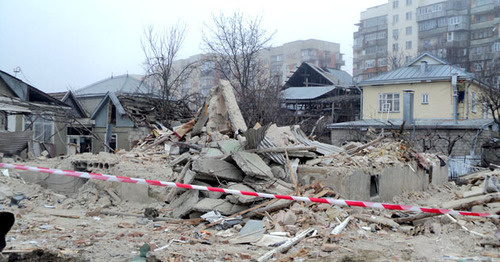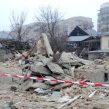
Insurgency in the Northwest Caucasus Remains Active
Publication: Eurasia Daily Monitor Volume: 13 Issue: 15
By:

A strange armed clash that took place in Nalchik, the capital of Kabardino-Balkaria, in mid-January had unexpected results for government forces. The authorities introduced a counterterrorist operation regime in the city, after which security forces sealed off a house in which, they claimed, three suspected militants with ties to the Islamic militant underground were holed up (Interfax, January 16). Residents of surrounding houses were evacuated to avoid civilian casualties, which often happen as a result of weapons fire by government forces.
According to security officials, a man in the house refused to let police officers into the house and opened fire on them with a rifle. “The officers tried to convince him to surrender and that is why the special operation lasted for so long,” a source said. The suspect let his mother leave the home but refused to surrender and shot one policeman in the neck. The police then decided to storm the building (newsru.com, January 16). To balance out the fact that one policeman was wounded in the incident, some sources “close to the police” claimed two militants were killed during the shootout (gazeta.ru, January 16).
The shooting finally stopped on the evening of January 16, but resumed with renewed force the next morning. A police source told the Kavkazky Uzel website that after the special operation finally ended, the police expected to find three corpses in the house, but found only one. The slain man was identified as the owner of the property, 39-year-old Alim Nakhushev, who was employed at a local auto repair shop. The police said he was an active accomplice of local militants (kavkaz-uzel.ru, January 18). Security forces used heavy machinery to clean up the ruins of the demolished house.
The police found a rifle, a pistol and five gas masks, and the slain man was wearing a gas mask. Still, his mother said that her son was not alone during the siege and she had seen him with someone she identified as Khizir Likhov (lifenews.ru, January 17). Thus, it appears that a two-day siege carried out by hundreds of security personnel using special equipment and other resources failed to prevent some of the militants from slipping away. It is unlikely that the police came across this house by accident: indeed, government officials were probably tipped off about the rebels’ location. It is quite likely that Alim Nakhushev sacrificed his life for a high-ranking militant, not for Khizir Likhov, so the latter probably did not escape alone. The police after the fact raised Alim Nakhushev to the level of a high-ranking militant, but he was not even on the wanted list of Kabardino-Balkaria’s Interior Ministry (07.mvd.ru). Apart from everything else, this also indicates that the official claims of how many rebels were involved in the siege are largely unfounded. Khizir Likhov was on the wanted list and accounted for, but there may be many people like Alim Nakhushev, who are unknown to the Russian security services.
Kabardino-Balkaria remains one of the most dangerous republics in terms of the activities of the militant underground movement. The number of counterterrorist operations in the republic increased three-fold in 2015 compared to the previous year (kavkaz-uzel.ru, January 16). Valery Khatazhukov, a local rights activist who heads the Kabardino-Balkarian human rights center, does not believe the security situation in the republic has deteriorated, at least in comparison to neighboring republics. However, Mikhail Roshchin, a well-known expert from the Institute of Oriental Studies at the Russian Academy of Sciences, believes Kabardino-Balkaria is the most problematic republic in the North Caucasus. According to Roshchin, Kabardino-Balkarian militants are mainly associated with the Caucasus Emirate rather than the Islamic State (ISIS), which makes the situation in the republic quite different from the other republics of the North Caucasus. However, it is hard to justify drawing such far-reaching conclusions from a single video address by Amir Salim (Zalim Shebzukhov), which was posted on YouTube at the end of last year (YouTube, December 28, 2015), and this view needs to be backed up by additional evidence, such as future rebel actions.
Nonetheless, there are also recruits of the so-called Islamic State in Kabardino-Balkaria, which makes it even harder for the security services to control the situation in the republic. According to Valery Ustov, the head of the Investigative Department of the Russian Investigative Committee in Kabardino-Balkaria, “128 residents of Kabardino-Balkaria are fighting in Syria on the side of ISIS, including some women.” He also said that 20 members of ISIS from the republic have been killed (Interfax, December 24, 2015). Ustov added that government forces had killed three militants who returned from Syria and imprisoned three others for joining armed groups fighting Bashar Assad.
The peculiarity of Kabardino-Balkaria is that its governor, Yuri Kokov, unlike the governors of Dagestan, Chechnya or Ingushetia, practically never comments on the situation related to the activities of the rebels. One gets the impression that the authorities in Kabardino-Balkaria are somehow removed from everything that is going on involving the insurgency in the republic. Yet the jamaat in the northwestern Caucasus remains one of the strongest in the region, and the authorities have little reason to believe that the security situation in Kabardino-Balkaria will be improving anytime soon.




